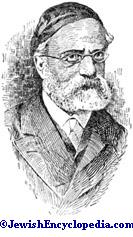HIRSCH, SAMSON RAPHAEL:
(Redirected from BEN UZZIEL.)German rabbi; born at Hamburg June 20, 1808; died at Frankfort-on-the-Main Dec. 31, 1888. His father, though a merchant, devoted much of his time to Hebrew studies; his grandfather, Mendel Frankfurter, was the founder of the Talmud Torah in Hamburg and unsalaried assistant rabbi of the neighboring congregation of Altona; and his granduncle, Löb Frankfurter, was the author of several Hebrew works. Hirsch was a pupil of Ḥakam Bernays, and the Biblical and Talmudical education which he received, combined with his teacher's influence, led him to determine not to become a merchant, as his parents had desired, but to choose the rabbinical vocation. In furtherance of this plan he studied Talmud from 1823 to 1829 in Mannheim under Jacob Ettlinger. He then entered the University of Bonn, where he studied at the same time as his future antagonist, Abraham Geiger.

In 1830 Hirsch was elected chief rabbi ("Landrabbiner") of the principality of Oldenburg, where he remained until 1841, when he was elected chief rabbi of the Hanoverian districts of Aurich and Osnabrück, with his residence in Emden. During this period he wrote his "Neunzehn Briefe über Judenthum," which were published, under the pseudonym of "Ben Usiel" (or "Uziel"), at Altona in 1836. This work made a profound impression in German Jewish circles because it was something new—a brilliant, intellectual presentation of Orthodox Judaism in classic German, and a fearless, uncompromising defense of all its institutions and ordinances. From the appearance of the "Nineteen Letters" dates the origin of the so-called "Neo-Orthodoxy," or the revival of Orthodox Judaism in somewhat modernized and esthetic form. The "Letters" have been translated into Hebrew and English ("Iggerot Ẓafon," by M. S. Aronson, Wilna, 1892; and "The Nineteen Letters of Ben Uziel," by Bernard Drachman, New York, 1899). In 1838 Hirsch published, as a necessary concomitant of the "Letters," his "Horeb, oder Versuche über Jissroel's Pflichten in der Zerstreuung," which is a text-book on Judaism for educated Jewish youth; in 1839, "Erste Mittheilungen aus Naphtali's Briefwechsel," a polemical essay against the reforms in Judaism proposed by Holdheim and others; and in 1844, "Zweite Mittheilungen aus einem Briefwechsel über die Neueste Jüdische Literatur," also polemical in tendency.
In 1846 Hirsch was called to the rabbinate of Nikolsburg in Moravia, and in 1847 he became chief rabbi of Moravia and Austrian Silesia. In Austria he passed five years in the reorganization of the Jewish congregations and the instruction of numerous disciples; he was also, in his official capacity as chief rabbi, a member of the Moravian Landtag.
In 1851 he accepted a call as rabbi of an Orthodox separatist group in Frankfort-on-the-Main, a part of the Jewish community of which had accepted Reform. This group, known as the "Israelitish Religious Society" ("Israelitische Religions-Gesellschaft"), became under his administration a great congregation, numbering about 500 families. Here Hirsch continued to labor until his death. He organized the Bürger- und Realschule, in which thorough Jewish and secular training went hand in hand; he founded and edited the monthly "Jeschurun" (1855-70; new series, 1882 et seq.), and wrote the following independent works: "Jüdische Anmerkungen zu den Bemerkungen eines Protestanten" (anon.), 1841; "Die Religion im Bunde mit dem Fortschritt" (anon.), 1854; "Uebersetzung und Erklärung des Pentateuchs," 1867-78 (5 vols; 3d ed. of vol i., 1893); "Das Princip der Gewissensfreiheit," 1874; "Der Austritt aus der Gemeinde," 1876 (the last two were written in advocacy of the Lasker law, adopted July 28, 1876, permitting Israelites to sever their connection with local congregations without leaving Judaism); "Uebersetzung und Erklärung der Psalmen," 1882; "Ueber die Beziehungen des Talmuds zum Judenthum," 1884, a defense of Talmudic literature against anti-Semitic slanders. He left in manuscript at the time of his death a translation and explanation of the prayer-book which was subsequently published. The publication, in several volumes, of his collected writings ("Gesammelte Schriften") was begun in 1902.
- Der Israelit, Mayence, Jan., 1889, and Sept., 1896;
- B. Drachman, Samson Raphael Hirsch, a Biographical Sketch, an introduction to his translation of the Neunzehn Briefe, etc.;
- Meyers Konversations-Lexikon, 5th ed.
